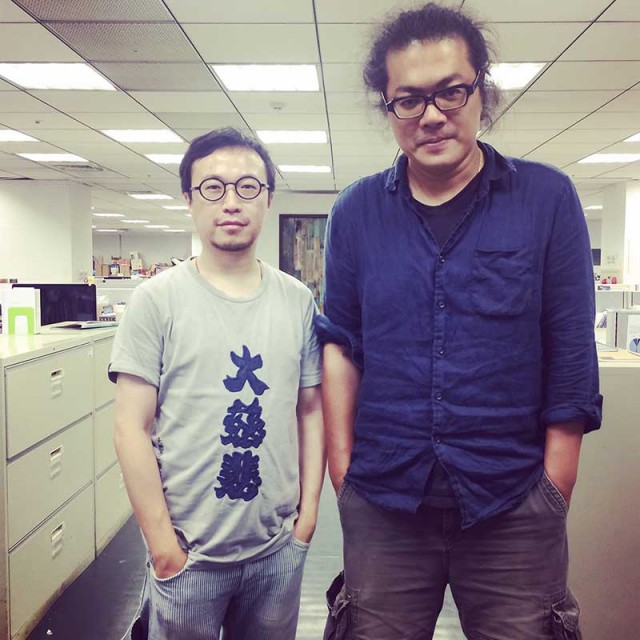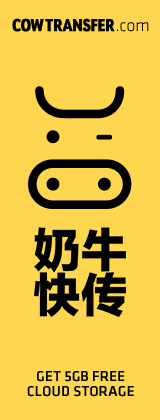年青的上海本地广告公司W每次推出的campaign都掷地有声,这次为新伯伦策划的campaign# 这是我们的原色#也不例外,主打的两条宣传片自上线之日起,无论在创意和影片制作水平上好评如潮。广告导演是台湾广告界大名鼎鼎的无冕之王罗景壬,虽然影 片的题材还是时下流行的“青春”片,不过这次它既不是青春的赞歌、也不是纪念逝去的挽词,更不是某个时代年轻人的的矫情和浮夸。相反,影片的镜头紧紧追随 着男女两位主角在现实与自我间的游走,几乎接近残酷地让他/她直面青春的挣扎与现实的百态。
为了让观众真切地融入到男女主角的感受,罗导运用了独特的镜头语言:男生篇里有一镜到底的长镜推移,女生篇里有一组多镜头的紧凑剪辑。画面的主色调是偏冷的蓝和绿,它还原的不是青春的缤纷,而是它真实的色彩。
对于影片创意上的深解和与罗导合作的详情,SHP+采访到了W公司的创建人李三水。

Founder of W, Water Lee (L) with Director GingZim Lo. W的创建人李三水(左)与导演罗景壬。
当初拿到NB的brief是怎么样的?最终的故事是由谁来撰写的?
W:最初的brief比较开放,主要针对2015年度NewBalance574的计划内品牌推广和曝光,但W则是没有直接切入产品,而是从品牌整体战略整合的方式进行解题,最后针对年轻目标群体输出#这是我们的原色#的策略诉求。最终故事设想,是W根据策略方向再细化为具体创意脚本后,和罗导沟通并合力完成。
可以介绍一下两个故事背后的创意来源和灵感吗?为什么选用了”从第一人物从跳出来,再用第三者眼光看自己“这样的构想?
W:主要的立意考虑是不想重复常规套路:改编平凡人的不平凡事迹,或一昧煽情励志的方法去和现代年轻人沟通,而想设计为基于生活现实却偏抽象表达的青春寓言手法将创意演绎,而第三者视角的设定,也是为了强化这一主题。
怎么会有机缘找到罗导合作?脚本有哪些地方打动了导演?
W:合作机缘得益于制片方上海千禧传媒的帮助。
其实真正打动导演之处,不在于脚本,而在于最初我们策略关切的角度: 跳过了广告创意最容易借题发挥的两类人:精英和屌丝,而聚焦在一群最难描述性状的人群上,他们并非不平凡的平凡大众,也不是非凡精英中的佼佼者,他们是平凡大众中的精英,精英里的中坚分子。
他们是所有广告策略中描述起来最空泛和表面的一群人,是所谓的中产阶级。面对要用创造性的手法,去讲述这样一群人的青春时代,罗导和W找到了同样的兴奋点:这少有人做过,或有人做过,但几乎没人做得出彩过。在我们幕后的讨论中,我和导演笑论,能把这样的故事说得好的,先不说广告圈,电影圈里,我们能看到的,只有杨德昌的《一一》、李安的《饮食男女》、小津安二郎的《秋刀鱼之味》。
缘此,W、客户和罗导一拍即合。
是否第一次与罗导合作?导演在工作过程中留给你最深刻的印象(细节)是什么?
W:是第一次,也是印象深刻,收获斐然的一次。有一句江湖传言:“台湾一半以上,获国际奖项以及广受好评的作品,都是他拍的。”而所有外界对一个实力大导演非常强势和不容侵犯的印象,在我这次所接触的罗导身上通通没有展现,我看到的只是一个儒雅稳健,逻辑思维与直觉感应极强的国际级导演风范,他可以像大师一样升华广告公司的创意,也可以像大哥一样照顾到客户的隐忧。
在第三人称看自己的表达手法上,这条片子在镜头的切换、后期的剪辑以及配色上都非常特别。你对这些拍摄的手法满意吗?准确地表达了你对”原色“的构想吗?
W:除了台湾广告风格稍微明显外,就整体而言,是满意的。
一些拍摄信息:在哪些地方拍的?两条片子用了多长时间?有多少人的团队?
W:两处拍摄地都在台湾。教室在国立台北大学,隧道在九份的废弃金矿遗址。纯拍摄时间大概仅两天,拍摄团队约20人。
在整个案子里遇到最大的挑战是什么?
W:有限时间内,要做到主题清晰表达。所以后期两条片子的文案撰写和修缮上,需下功夫。

One of the shooting locations is in the tunnel of an abandon tunnel in Taiwan. 取景地之一是台湾的九份一个废弃金矿里的隧道。
W在近期做了许多成功的H5案子,也交出了不少精彩的影视广告作品。我知道你的团队不大,你们是如何分配资源的?
W:精化团队,合理分工。
现在你们的定位是更偏重哪个方面,交互数码还是视频?
W:其实外界对W的认知上多有偏差,W即非传统意义上的互动技术公司,也非所谓的创意热店,而是具备年度品牌操盘能力的,具备互动技术优势的一家新型营销机构。
你认为你可以在如此短的时间内取得这么成就的主要原因有哪几个?
W:恰如上题所答。主要原因正是在于外界原以为W是这样,而W却是另一番模样。
The young Shanghai advertising agency W has created a buzz around every one of their campaigns so far. Their latest campaign for New Balance, #This is Our True Colour#, is no exception. The creative idea and production quality of the two films won admirers within both the media and the ad industry the moment it hit the web. The director of the spots is GingZim Lo, one of the best-known and prolific directors in Taiwan. For him, the films are not just another reminiscence of past dreams or an ode to lost youth. In this story, the camera documents the almost ‘brutal’ reality the young people are facing.
To create empathy with the film’s lead characters, Lo applies a unique camera language in each film: in the boy’s chapter, the hero’s movement is captured in one long shot; while for the girl, a sequence of intense, rapid-fire shots are employed. The blue and greenish color tone of the film suggests this is not the picture of a colorful, young life that you might imagine, but rather stories of hard truth.
SHP+ interviewed W founder, Water Lee, about the creative thinking behind the campaign, and cooperating with Lo.
What was the brief from New Balance? Who came up with the two stories?
W: The original brief was quite open, mainly based on the brand promotion strategy for NewBalance574 in 2015. However, W didn’t focus directly on the product. Instead we studied the brand’s overall strategy in an integrated way, and finally came up with the campaign idea: ‘This Is Our True Colour’. Based on this creative idea, W refined the script and completed the storyboard with Director GingZim Lo.

The boy’s spot was shot in a classroom in Taiwan National Taipei University. “男生篇”的取景地是国立台北大学的教室。
What are the inspirations of the story? Why did you decide to have the characters refer to themselves in the third person?
W: The main consideration was to avoid repeating the conventional means of conceiving a story, which is usually adapting an extraordinary event for an ordinary person, or trying to communicate with young people in an overly sensational way. We wanted to express the creative idea through a realistic, ordinary person, whilst also giving it a slightly abstract expression, similar to a sort of fable of youth. Setting the narration from a third party perspective was used to reinforce this theme.
Why did you select Lo as the director? Which aspect of the storyboard most appealed to Lo when you first approached him?
W: We would like to thank Shanghai Millennium Media, a local production company, for introducing Lo to us.
In fact, it was not the storyboard that excited the director the most, it was in fact the campaign’s target audience. Most of the creative ideas these days target either the ‘elites’ or the ‘wannabes’. In this campaign, our target audience has no label. These people are the special ones amongst the ordinary, and the core group amongst the ‘elite’. These people are thought of by most advertisers as a kind of superficial, hollow middle class. But we felt they deserve better.
We wanted to tell stories that recreate their youthful experiences. Luo and W found this is an intriguing idea to explore – very few people have tried this, and even fewer have done it well. We both agreed that no commercials had successfully told a story with this theme. Only very few Chinese movies have been successful with this approach – Taiwanese director Yang Deng Chang’s “11”, Ang Lee’s “Eat Drink Man Woman” and Yasujiro Ozu’s “Autumn Afternoon”.
Once we began exchanging ideas, we hit it off with Lo.
Is this the first time you have worked with Lo? What was it about working with him that impressed you the most?
W: It was the first time. I am very impressed and inspired by him. There is a rumour that more than half of the internationally-awarded and critically-acclaimed spots in Taiwan are done by Lo. Before meeting him, I assumed that such a powerful director would be unapproachable and domineering whereas, in fact, the opposite is the truth. I saw a mature and polite international director with strong logical thoughts and intuition. He applied a magic touch to all of our creative ideas, whilst at the same taking care of the customer’s needs, like a big brother.
Talk us through the creative decisions regarding the look – camera angles, editing and colors. Are you happy with the film overall?
W:In general I am happy with the tone, except that the Taiwanese style is a bit too obvious.
Tell us a little bit about the shoot.
W: The shoot took place in two locations in Taiwan. One was in the classroom of National Taipei University. The other was a tunnel in the abandoned gold mine sites in Jioufen area. The two films took two days to shoot with a team of 20 people.
What were the biggest challenges throughout the process, from brief to execution?
W:To fully and clearly express the campaign idea within a limited timeframe. The creation and the revision of the ad’s script also required a lot of effort.
ABOUT W
W have produced some successful and influential campaigns on HTML5. Alongside that, the agency has delivered some highly acclaimed advertising films. How do you allocate your resources across two such different fields?
W:Refine the team resources. Smartly allocate works.
How are W positioning themselves – interactive digital or branded film-making?
W: There are some misconceptions about W in the industry. W is not an interactive technology company in the traditional sense, nor a so-called creative hot shop. It is a new type of marketing agency with branding capacity and the advantages of new interactive technology.
How have W become so successful in such a short period of time?
W:The answers are above. A lot of people make assumptions about W, but we are actually another type of W altogether.






> Comments